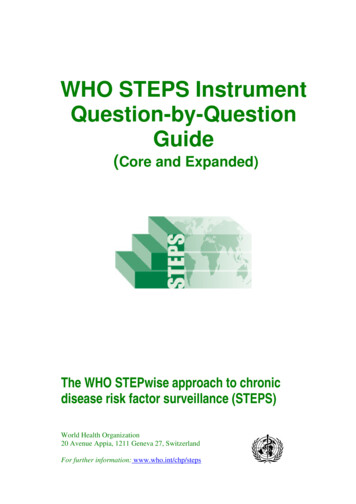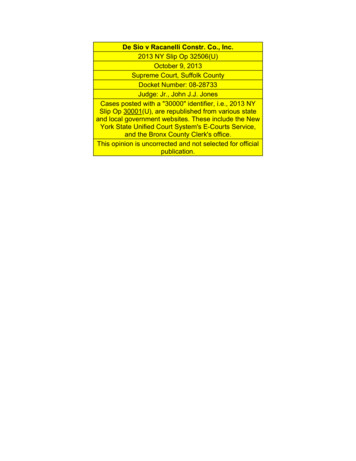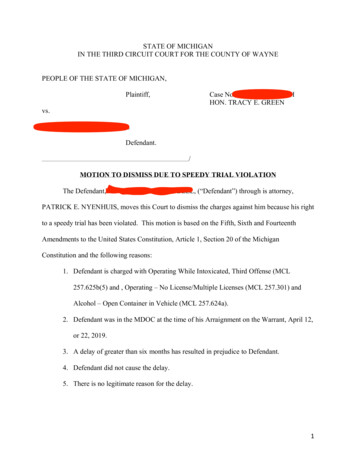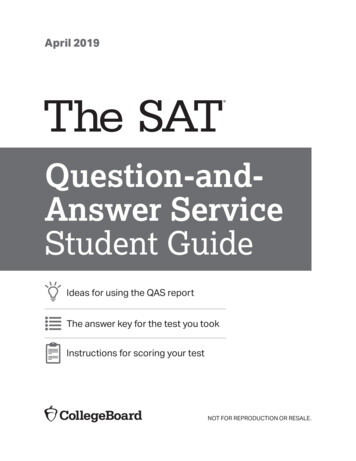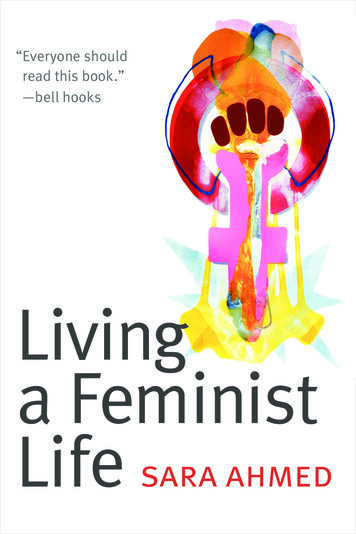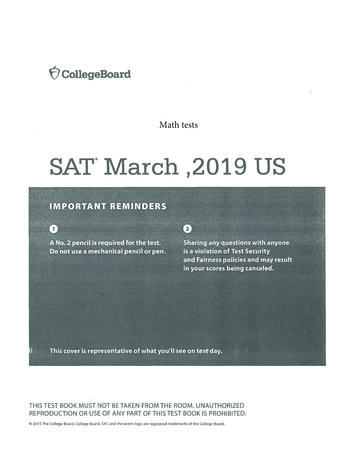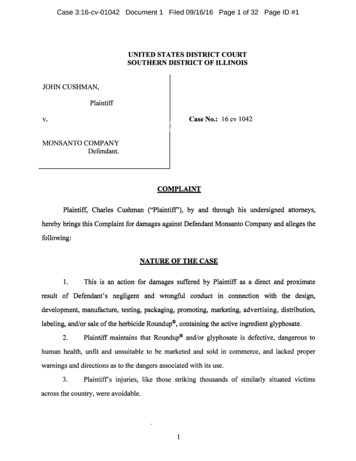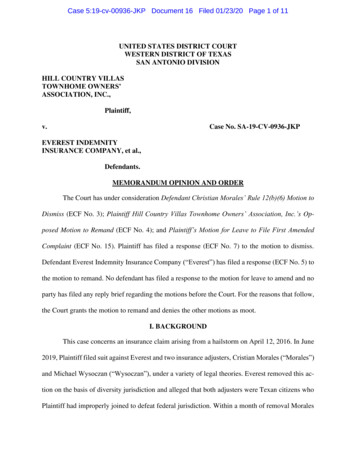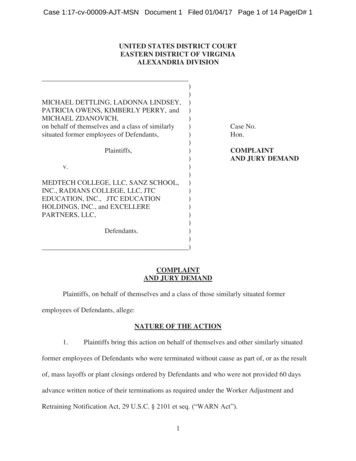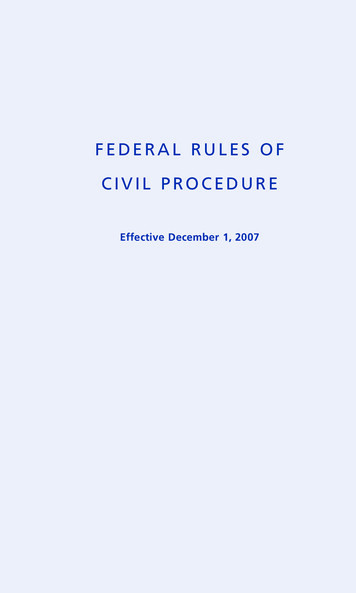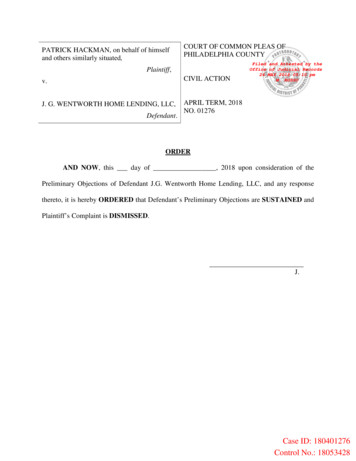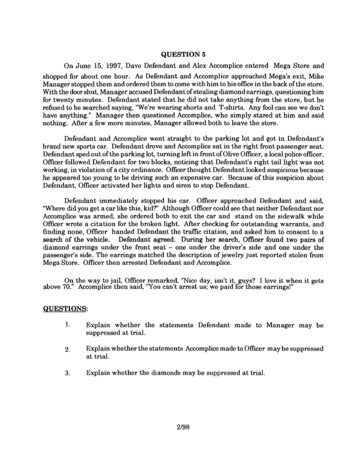
Transcription
QUESTION 5On June 15, 1997, Dave Defendant and Alex Accomplice entered Mega Store andshopped for about one hour. As Defendant and Accomplice approached Mega's exit, MikeManager stopped them and ordered them to come with him to h s office in the back of the store.With the door shut, Manager accused Defendant of stealing diamond earrings, questioning himfor twenty minutes. Defendant stated that he did not take anything from the store, but herefused to be searched saying, "We're wearing shorts and T-shirts. Any fool can see we don'thave anything." Manager then questioned Accomplice, who simply stared at him and saidnothing. After a few more minutes, Manager allowed both to leave the store.Defendant and Accomplice went straight to the parhng lot and got in Defendant'sbrand new sports car. Defendant drove and Accomplice sat in the right front passenger seat.Defendant sped out of the parking lot, turning left in front of Olive Officer, a local police officer.Officer followed Defendant for two blocks, noticing that Defendant's right tail light was notworking, in violation of a city ordmance. Officer thought Defendant looked suspicious becausehe appeared too young to be driving such an expensive car. Because of this suspicion aboutDefendant, Officer activated her lights and siren to stop Defendant.Defendant immediately stopped his car. Officer approached Defendant and said,"Where did you get a car like this, kid?' Although Officer could see that neither Defendant norAccomplice was armed, she ordered both to exit the car and stand on the sidewalk whileOfficer wrote a citation for the broken light. After checlung for outstandmg warrants, andfinding none, Officer handed Defendant the traffic citation, and asked him to consent to asearch of the vehicle. Defendant agreed. During her search, Officer found two pairs ofdiamond earrings under the front seat - one under the driver's side and one under thepassenger's side. The earrings matched the description of jewelry just reported stolen fromMega Store. Officer then arrested Defendant and Accomplice.On the way to jail, Officer remarked, "Nice day, isn't it, guys? I love it when it getsabove 70." Accomplice then said, 'You can't arrest us; we paid for those earrings!"QUESTIONS:1.Explain whether the statements Defendant made to Manager may besuppressed at trial.2.Explain whether the statements Accomplice made to Officer may be suppressedat trial.3.Explain whether the hamonds may be suppressed a t trial.
DISCUSSION FOR QUESTION 5DEFENDANTS STATEMENTS TO MANAGERMiranda warnings are required for any person before a police custohal interrogationtakes place. Miranda v. Arizona, 384 U.S. 436 (1966). The warnings are not required whenthere is no government conduct. See, ex. Illinois v. Perkins, 496 U.S. 292 (1990). MikeManager is not a police officer and was not acting under color of state law. Therefore, Managerwas not required to give Miranda warnings before asking questions of Defendant. Defendant'sstatements to Manager are admissible despite the absence of Miranda warnings.ACCOMPLICE'S STATEMENTS TO OFFICERPolice officers are required to give Miranda warnings before questioning any arrestee.However, Officer &d not interrogate Accomplice before his statement. Although interrogationcan include not only questions, but also any statement designed to elicit an incriminatingresponse, asking about the weather does not fall into that category, and Alex's statement isadmissible.DIAMONDS1. Traffic StopIf Olive's initial stop of the vehicle was invalid, then all the flows from that illegalitymust be suppressed as "fruit of the poisonous tree." Olive's reason for stopping the car - thatDave seemed too young to be driving an expensive car - was not a legitimate basis on whichto stop a vehicle. However, an officer's motive for a traffic stop does not invalidate otherwiseobjectively justifiable conduct under the Fourth Amendment. Whren v. United States, 116S.Ct. 1769 (1996). An officer's subjective intent in making a stop is irrelevant under theFourth Amendment. Whren. If a police officer has probable cause to believe a violation hasoccurred, the stop is valid. Whren. The broken brake light provided an objective reason for thestop, which is therefore permissible under the Fourth Amendment, despite Olive's invalidsubjective reason.Police officers have discretion to order passengers out of cars stopped for routine trafficviolations even when an officer has no reason to suspect a passenger has committed a crimeor threatens the officer's safety. Maryland v. Wilson, 117 S.Ct. 882 (1997). Oliver &d not actinappropriately in ordering Dave and Alex from the car.2. ConsentAny warrantless search without probable cause must fall within a n exception to theFourth Amendment. Although there is an automobile exception, this requires probable cause,which Olive clearly &d not have. The other relevant exception is that the search wasconducted pursuant to a knowing and voluntary consent. A police officer may ask motoristsdetained for traffic violations for permission to search their cars without advising them thatthey have the right to refuse. Ohio v. Robinette, 136 L.Ed.2d 347 (1996). Olive &d not violateDave's rights by asking for his consent or by searching pursuant to that consent.
DISCUSSION FOR QUESTION 5PAGE TWOTo challenge a search under the Fourth Amendment, the defendant must havestanding. This means that the defendant must have a reasonable expectation of privacy in theplace searched or of the item seized. A defendant can only challenge the search if it violateshis or her own reasonable expectation of privacy. Rakas v. Illinois, 39 U.S. 128 (1978).Defendant had a reasonable expectation of privacy in his car, but Alex had none. Dave hasstanding to challenge the search; however, the seizure of the diamonds violated none of Alex'sconstitutional rights, and are clearly admissible against Alex. Accordmgly, the hamonds areadmissible against both Dave and Alex.
Examinee #Final ScoreSCORESHEET FOR QUESTION 5ASSIGN ONE POINT FOR EACH STATEMENT BELOWRecognize Miranda issues.Miranda applies to custodml interrogations.Recognize issue of government actionJcolor of state law.Miranda requires interrogation (statement designed to elicita response).To challenge a search under the Fourth Amendment, a defendantmust have standing.Alex has no standing to challenge the search of the car becausehe has no reasonable expectation of privacy under Dave's front seat.Offker's subjective reasons for the stop are irrelevant if there is anobjective reason to support the stop.Recognize issue that Officer had a lawful reasonlprobable cause forthe stop because of the broken light.A police officer may order the driver and the passengers of a stoppedvehicle to exit the vehicle during a traffic stop.To be valid, a police search must be pursuant to a warrant andprobable cause, unless it falls within a recognized exceptionto the Fourth Amendment.Recognize consent an exception to the Fourth Amendment.The police need not advise a suspect that he has the right to refuseto consent.
QUESTION 6Sam Jones was found shot to death in his house. His wallet and a pistol with his nameon it were missing, but there was no sign of a forced entry. Officers Brown and Richards talkedto the neighbors who could only tell them that they had seen no one but a plumber from A-1Plumbing at Jones' house that day. Brown contacted A-1 and determined that the plumberwho was at Jones' house was Mark Smith.Officers Brown and Richards then went to Smith's house. As they approached thehouse, they observed a man leaving through the front door. When the man identified himselfas Smith, Richards pushed him up against the wall and patted him down. Richards felt whathe thought was a pistol and removed it from Smith's pocket, at which time he noticed it hadSam Jones' name on it. Continuing with the pat down Richards felt a wallet, pulled it out ofSmith's pocket, looked a t its contents, and discovered a credit card issued to Sam Jones.QUESTION:Discuss the admissibility of the pistol and the credt card a t Smith's murder trial.
DISCUSSION FOR QUESTION 6The pistol and credit card could be excluded from evidence a t Smlith's trial if they werethe fruit of a n illegal search and seizure under the Fourth Amendment. won Sun v. U.S., 371U.S. 4'71, 83 S.Ct. 407 (1963); Murray v. U.S., 487 U.S. 533, 536-37, 108 S.Ct. 2529, 2533(1988). Whether the officers violated the Fourth Amendment depends on how muchinformation they had and how intrusive their conduct was."The first issue concerns how much information the officers had. In order to make a validarrest the officers needed probable cause to believe that a crime had been committed and theperson being arrested committed it. In order to make an investigatory stop, however, theofficers only need a reasonable or articulable suspicion. Terrv v. Ohio, 392 U.S. 1, 88 S.Ct.1868 (1968). Here, it seems doubtful that they had probable cause to believe Smith murderedJones. The fact that Smith was a t the murder scene that day, that no one else was seen, andthat the murderer was possibly let in the house would, however, seem to lead to a reasonablesuspicion of Smith's involvement. Thus the officers were justified in engaging in aninvestigatory stop of Smith.The inquiry then turns to how extensive a search'can be conducted pursuant t i a ninvestigatory stop. Under Terry v. Ohio the officers are permitted to conduct a limited friskof the person for weapons if there is reasonable suspicion to believe the person is armed andpresently dangerous. Since the officers had a reasonable suspicion that Smith may have beeninvolved in the murder, it seems fair to say they could also believe Smith was armed and'dangerous. The frisk for a weapon, then, was valid, and the gun would subsequently beadmissible in court.The search which dscovered the wallet could not be justified under Terry because itwent beyond a limited search for weapons. However, because the officers first found the pistolwith Jones' name on it, the officers would have probable cause to arrest Smith for the murderof Jones. Upon arrest the officers could conduct a more extensive search incident to arrestwhich would allow them to look in Smith's wallet. In the case of a lawful custodial arrest, fullsearch of arrestee's person is not only an exception to the warrant requirement of the FourthAmendment but is also a "reasonable" search under that Amendment. U.S. v. Robinson, 414U.S. 218,,94 S.Ct. 467 (1973).
Examinee #Final ScoreSCORESHEET FOR QUESTION 6ASSIGN ONE POINT FOR EACH STATEMENT BELOWSCORE SHEETEvidence will be suppressed if seized in violation ofFourth Amendment.Probable cause is needed for an arrest.Reasonable or articulable suspicion of criminal activity isneeded for an investigatory stop.3.A stop is less intrusive than an arrest.4.A frisk is allowed if there is reasonable suspicion that a person ispresently armed and dangerous.5.The frisk is limited to a search for weapons.6.The search of the wallet could not be justified as a frisk.7.The search of the wallet could be justified as a search incidentto arrest.8.
QUESTION 4Officer Oliver was staking out a burnt out, boarded up buildmg that was used asa drop off point for drug transactions. A little after midnight, Officer saw Dave Defendantgo into the house. He had seen Defendant go in and out of the house on previous occasions.Fifteen minutes later, Defendant came out carrying a small package and placed thepackage in the trunk of h s car. After Defendant got in the car, but before he could driveoff, Officer stopped h m . Officer then searched the car and found the package in the trunk.It contained a kilo of heroin. Officer then arrested Defendant.QUESTION:Discuss Defendant's constitutional rights with regard to prosecution for possessionof a controlled substance.
DISCUSSION FOR QUESTION 4Under the Fourth Amendment exclusionary rule, evidence derived from a warrantlesssearch must be suppressed unless it fits within one or more of the six exceptions to the warrantrequirement. Michigan v. Tvler. 436 U.S. 499 (1978). Here, because Officer Oliver did notobtain a warrant to search Dave's car, the exceptions must be examined.The first possible exception is for a "search incident to a lawful arrest." Weeks v. U.S.,232 U.S. 383 (1914). The question whether a search prior to the actual arrest fits with thisexception has been left open by the Supreme Court. Michigan v. Long. 463 U.S. 1032 (1983).Even if the exception covered such situations, it would not apply here because it only extendsto searches of the passenger compartment, and not to the trunk. New York v. Belton, 453 U.S.454 (1981).The second possible exception is the "stop and frisk" exception, which requires theofficer to have an articulable and reasonable suspicion of criminal activity and is limited to aprotective frisk for weapons. Terry v. Ohio, 392 U.S. 1 (1968). When the suspect is in anautomobile, the protective frisk extends to the passenger compartment of the car. Michipan v.Long, 463 U.S. 1032 (1983). Here, Officer Oliver's previous observations of Dave going in andout of the house and seeing Dave bring a small package out constituted an articulable andreasonable suspicion of criminal activity. Ker v. California. 374 U.S. 23 (1963). Nonetheless,there is no indication he thought Dave was armed, and, in any event, his search went beyondthe passenger compartment.The third possible exception is the "plain view" exception. Coolidge v. New Ham shire,403 U S , 443 (1971). To fit within this exception 1) the police must legitimately be on thepremises, 2) inadvertently discover the fiuits of the crime, and 3) see the evidence in plainview. Id. Here Officer Oliver was legitimately on the premises and stopped Dave because hehad an articulable and reasonable suspicion that criminal activity was taking place. However,he could not have inadvertently seen the heroin in plain view, as it was wrapped up in thetrunk.The fourth exception is the "consent" exception, whch requires that consent beD U.S. 328 U.S. 624 (1946). Here, novoluntarily given before a search commences. Z v.consent was given.The fifth exception is the "hot pursuit/evanescent evidence" exception. Warden v.Hayden. 387 U.S. 294 (1967); Schmerber v. California. 384 US. 757 (1966). It does not applyhere because Officer Oliver did not have to pursue Dave and there was no reason to believethat the heroin was going to be destroyed immediately.The final possible exception is the "automobile" exception, which requires that theofficer have probable cause to believe the vehicle contained evidence or instrumentalities of acrime before he searches it. Carroll v. U.S., 267 U.S. 132 (1925). It is not limited to thepassenger compartment, but extends to the trunk and packages within it. U.S.V. Ross, 456U.S. 798 (1982). Here, because Officer Oliver had probable cause prior to the search, see Kerv. California, 374 U.S. 23 (1963), and the heroin was found in the trunk, the automobileexception is met and the heroin is admissible.
Essay 4 GradesheetSeatPlease use blue or black penand write numbers clearly1.Fourth Amendment prohibits search and seizure absent a warrantor an exception.2.Exclusionary Rule prohibits the admission of evidence seized inviolation of the 4'h Amendment.No warrant, so seizure must fit within one of six exceptions:Search incident to a lawful arrest exception.3a.3Search incident to a lawful arrest exception onlyencompasses search of passenger compartmentand not trunk.Stop and frisk exception.4a.Police must have articulable and reasonable suspicionof criminal activity.4b.Limited to protective frisk for weapons.4c.Further limited to the passenger compartmentof a vehicle.4.4b.Plain view exception (not applicable).5.Consent exception (not applicable).6.Hot pursuit or evanescent evidence exception (not applicable).7.Automobile exception.8a.Police must have probable cause to believe vehiclecontains evidence of crime before the search is made.8b.Covers entire car, including packages in trunk.
QUESTION 8Vicki Verity was a t home when Sam Smooth knocked on her door andasked to use her phone. Despite some apprehension, she let him use thephone, but watched him closely. Upon finishing his call, Sam pulled out aknife, grabbed Vicki, threatened her, and assaulted her. After Sam leftVicki's, she called the police and gave a detailed description of Sam includingh s height, weight, age, and his hair color and length. She also reported thathe had a n earring in his ear, and the type of clothing he was wearing.An officer responding to Vicki's call observed a male who matched thedescription perfectly. He stopped and called to Sam who was across thestreet. Sam came across the street and the officer placed him under arrest.Sam was taken to the police station and photographed.Another officer brought Vicki to the police station. She was informedthat a n arrest had been made of a suspect matching the description she hadgiven. She identified Sam Gom a photo line-up. He was the only personwearing clothes exactly matching her description. After she identified Sam'spicture, a police officer told her she had picked the person they had arrested.At a suppression hearing approximately two months after the assault,Vicki identified Sam a s her assailant. She testified that she had observedhim for approximately t e n minutes before and during the assault, and the incourt identification was based on t h a t observation. She was certain t h a t Samwas the person who had assaulted her.QUESTION:Discuss the constitutional issues t h a t Sam's attorney can argue infavor of suppressing Vicki's identification of Sam, the prosecution's response,and the court's likely rulings.
DISCUSSION FOR QUESTION 8An out-of-court pretrial identification by a witness of an accused can be "sounnecessarily suggestive and conducive to irreparable mistaken identification" thatit denies a defendant due process of law under the Fourteenth Amendment. Stovallv. Denno, 388 U S . 293, 301- 02, 87 S.Ct. 1967, 1972, 18 L.Ed.2d 1199, -(1967);P e o l ev. Monroe, 925 P.2d 767, 771(Colo. 1996. A valid due process claim forsuppression of identification testimony must involve a pretrial procedure, which is"so impermissibly suggestive as to give rise to a very substantial Likelihood ofirreparable misidentification." Simmons v. United States, 390 U.S. 377, 384,88S.Ct. -, 971 (1968); Monroe, id. To determine whether such a violation occurred,a court should examine the totality of circumstances surrounding the identification.Stovall, 388 U.S. at 302, 87 S.Ct. at 1972-73; Coleman v. Alabama, 399 U.S. 1,4-5,90 S.Ct. 1999,2000-2001,26 L.Ed.2d 387 (1970); Monroe, id. If the court finds thatthe identification is sufficiently tainted, subsequent in-court identification must besuppressed unless the state can prove by clear and convincing evidence that the incourt identification of the accused is based upon a source independent of the illegallineup identification. United States v. Wade, 388 U.S. 218, 87 S.Ct. 1926, 18L.Ed.2d 1149 (1967).Discussion of the photo Line-up should recognize the possibility that it wastainted. The array may have been unrepresentative because Sam was the only onewearing clothing exactly matching Vicki's description. The fact that Sam wasphotographed in the same clothes he wore upon his arrest, which were part of thedescription, could be a problem. The officer advising Vicki that a person matchingher description had been arrested may have been unduly suggestive. Anunconstitutional photo Lineup would subsequently taint any in court identificationof the defendant by the victim. The examinee should therefore discuss thesubsequent ideniiflcation offered by the victim at the suppression hearing. .In Wade, supra, the Supreme Court established that an independent basisfor an in court identification was necessary when the out of court identification wasquestionable or excluded. 388 U.S. at 239-40, 87 S.Ct. at 1938-39. Monroe, 925P.2d at 669-70. A defective out of court identification therefore does not requiresuppression of an in court identification if there is an independent basis. The testthat has evolved is whether the prosecution can show under the totality of thecircumstances that the identification was reliable, even though the out of courtidentification was suggestive. Neil v. Bimers, 409 US 188 (1972). The factors to beconsidered in making this determination are (1) the opportunity of the witness toview the criminal at the time of the crime; (2) the witness's degree of attention; (3)the accuracy of the witness's prior description of the criminal; (4) the level ofcertainty of the witness; (5) the length of time between the crime and theconfrontation. See also Manson v. Braithwaite, 432 U.S. 98 (1977), Stovall v.Denno, 388 U.S. 293 (1967), Simmons v. US., 390 U.S. 377 (1968) and People v.Humlev, 577 P2d 746 (Colo. 1978).
Essay 8 GradesheetSeatScoremPlease use blue or black penand write numbers clearly1. An improper identification of the defendant violates his or herXIVth Amendment right to due process.2. Lack of an attorney a t the lineup may give rise to 6thamendment (right tocounsel) challenge.2a. Courts, however, have found that the 6thamendment does not apply tophoto lineups.3. An identification is constitutionally improper when:a. the identification is unnecessarily suggestive, andb. there is a substantial likelihood of misidentification.4. The claim of an impermissibly suggestive identification must beevaluated in light of the totality of the surrounding circumstances.5. Here, those things might be:a. Officer advising Vicki the police had arrested a person matchingher description,5a.b. Sam's picture being only one with clothes matching descriptionand his being photographed in clothes he was arrested in.c. Officer telling Vicki she had identified the person police arrested.5c.6. An in-court identification may be allowed if it has a source sufficientlyindependent of any unconstitutional pretrial violations.7. Factors to be considered if there is an independent basis for the in-court identification are:a. the witness' opportunity to view the criminal a t the time of thecrime,b. the witness' degree of attention,7b.c. the accuracy of the witness' prior description of the criminal,7c.d. the level of certainty of the witness, and7d.e. the length of time between the crime and the confrontation.7e.8. Discussion of court's likely rulings.8.-
QUESTION 9David is currently being tried for burglary and other related charges. He had gone to Victoria'shouse, entered through a basement window, and removed a computer and some files. David and Victoriaare married, but in the middle of an acrimonious divorce and living apart. When he was arrested, Davidclaimed that he was confused about whether the computer belonged to him or to Victoria.Several weeks before this incident, David was arrested for embezzling money from his employer.In connection with that case, he was sent to the state mental hospital for a psychiatric evaluation and laterwas released. There was no report issued from that evaluation.When attempting to impanel a jury for David's trial for the burglary, David's attorney used hisfirst four peremptory challenges to excuse four women. When he attempted to utilize his fifth peremptorychallenge to excuse another woman, the prosecutor objected, claiming that David's attorney hadimproperly exercised his peremptory challenges to reduce the number of women on the jury. David'slawyer explained that he wished to excuse the juror because she had indicated that she was divorced, andhe had not had an opportunity to question her about the circumstances of her divorce.After a jury was empaneled and David's trial had begun, Victoria testified about David'smisconduct during the marriage, including his failure to make mortgage payments and pay their bills. Oncross-examination, the defense learned that Victoria had made statements consistent with this testimonyto the police when, prior to trial, she was questioned about the burglary. David's attorney moved for amistrial on the ground that the prosecution had not disclosed the statements to the defense prior to trial.QUESTION:1.Assuming the trial judge knows about David's mental evaluation, discuss the appropriateaction(s) she should take.2.Discuss how the trial judge should rule on the prosecutor's objection and the standardswhich apply to these circumstances.3.Discuss how the trial judge should rule on the motion for a mistrial.
DISCUSSION FOR QUESTION 9Ouestion 1Due process prohibits the trial of a defendant who is incompetent to stand trial. A defendant iscompetent to stand trial if, at the time of the trial, he is capable of understanding the nature and courseof the proceedings against him and of participating and assisting in his defense and cooperating withdefense counsel. Duskv v. United States, 362 U.S. 402 (1960). If there is evidence that a defendantmay be incompetent, the trial judge has a constitutional obligation to conduct further inquiry anddetermine whether, in fact, the defendant is incompetent. Pate v. Robinson, 383 P.2d 375 (1966).There is, however, an initial presumption of competency. Once competency is raised, most statesrequire a criminal defendant to prove that he is not competent to stand trial by a preponderance of theevidence. It does not violate due process to require the defendant to prove that he is incompetent.Medina v. California, 505 U.S. 437 (1992).Here, the judge is aware that David had been sent to the state hospital for an evaluation inconnection with the other case, and David claims that he was confused at the time of the offense aboutwho owned the computer he took, there is no indication that he was incompetent at the time of trial.Thus, there is probably not enough evidence to give rise to a sufficient doubt of his competency at thetime of the trial to require the court to suspend the proceedings and make a competency determination.Question 2In Batson v. Kentucky, 476 U.S. 79 (1986), the United States Supreme Court held that aprosecutor's use of peremptory challenges purposefully to eliminate prospective jurors on the basis ofrace is a violation of the equal protection clause of the Fourteenth Amendment. This holding was laterextended to prohibit the exclusion of prospective jurors on the basis of gender. J.E.B. v. Alabama exrel. T.B., 51 1 U.S. 127 (1994). Here, although it is the defendant, not the prosecution, whoseperemptory challenges are allegedly discriminatory, it is still unconstitutional to use peremptorychallenges in a discriminatory manner. Georgia v. McCollum, 505 U.S. 42 (1992).A trial court should follow a three-step process in evaluating claims of racial or genderdiscrimination in jury selection. Batson, suma; P e o l ev. Cerrone, 854 P.2d 178 (Colo. 1993). First,the party who made the Batson objection (here, the prosecution) must make a prima facie showing ofpurposeful discrimination. Such a showing can be made with facts or circumstances that raise aninference that the exclusion of potential jurors was based on race or gender. Second, if the requisiteshowing is made, the burden shifts to the party attempting to utilize the peremptory challenge (here,the defendant) to articulate a gender-neutral explanation for excluding the juror in question. Theproffered reason need not be reasonable, as long as it is race or gender-neutral. Purkett v. Elem, 115S.Ct. 1769 (1995). Third, if a neutral explanation is presented, the objecting party (here, theprosecution) should be given an opportunity to challenge the showing of neutrality. The trial courtmust then determine whether the neutral reason is a pretext for purposeful discrimination. P e o l ev.Cerrone, s u r a P; e o l ev. Saiz, 923 P.2d 197 (Colo. App. 1995), m. denied, -U.S. -, 117S.Ct. 715, 136 L.Ed.2d 634 (1997).Here, David's lawyer's pattern of striking women from the venire raises an inference ofpurposeful discrimination and satisfies step one of the Batson analysis of making a prima facie case ofgender discrimination. The proffered explanation (that he had not questioned the juror about her
DISCUSSION FOR QUESTION 9Page Twodivorce and was concerned about the circumstances) is gender-neutral, and satisfies his burden at steptwo of the Batson analysis of presenting a gender-neutral reason for the peremptory challenge. Theprosecution may challenge that reason, but it is the court which must decide whether the profferedreason is a pretext for gender-discrimination. A determination either way would be reasonable and notan abuse of discretion. It was arguably reasonable for defense counsel to be concerned about a jurorwho might also have gone through a hard-fought divorce.The prosecution has a duty to disclose material exculpatory evidence to the defendant. Bradvv. Marvland, 373 U.S. 83 (1963). Failure to disclose such evidence violates the due process clause,and a conviction arising from a case where exculpatory evidence has not been disclosed will beoverturned if "there is a "reasonable probability that, had the evidence been disclosed to the defense,he result of the proceeding would have been different. " Kvles v. Whitelv, 115 S.Ct. 1555 (1995);United States v. Baeley, 473 U.S. 667 (1985).Here, because the information the prosecution failed to disclose was not exculpatory, there wasno constitutional duty to disclose it. Moreover, there is no reasonable probability that had theVictoria's statements to the police been disclosed to the defense, the result of the trial would have beendifferent. Her statements were not about the offense with which David is charged, and the informationshe provided was within David's knowledge. Thus, David cannot claim that he was surprised by thetestimony. (Even if the prosecution had a duty to disclose the information, a mistrial would not bewarranted because d
brand new sports car. Defendant drove and Accomplice sat in the right front passenger seat. Defendant sped out of the parking lot, turning left in front of Olive Officer, a local police officer. Officer followed Defendant for two blocks, noticing that Defendant's right tai
